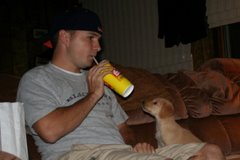
Long term memory is stored in networks of schemas.
Schemas and scripts are closely tied in with semantic memory and long term memory. Schemas are your knowledge of situations and events. Every new teacher has a pretty good idea of what a classroom looks like. They have a “schema” for the design of the interior of a classroom. When my students come into my room, I have the rules posted with pictures of what I expect (how to sit in a chair correctly, how to sit at carpet time, etc.). This is new to them, and they look up at the board to help them understand the rules. After awhile it is engrained in their schema of what should be done. When they have done it day after day they realize what they should be doing because it is in their long term memory. They have that picture in their head of what they should be doing and do not even need to look up at the board as a reminder.
"Scripts record the particular goals and activities that take place in a particular setting at a particular time." (Gallagher and Frith, 2003, p.77)
I think of scripts, the same way I think of a movie script. These are a sequence of events that are encoded into your memory on how to do something. An example given in Gallagher and Frith’s article was that of the restaurant script. Parts of this script would include reading the menu, ordering drinks and getting the bill. In addition they added that if you were to make a gesture of writing on your hand to your waiter, he would most likely know that script and bring you your bill. (Gallagher and Frith, 2003, p. 77) Many teachers set up routines in their classrooms. In my classroom I have a “script” for the children to follow when they come into the room. They are to put their coat and their book bags in their locker and take their folder to their desks. Then they are to sharpen their pencils and begin on an activity that I have prepared at their desk. They are used to following this routine after a few weeks of class. They follow this script, just like an actor has to follow a script in a play.
In my classroom, I sometimes model different scripts that I wish for them to follow. At times these scripts can conflict with the students already existing scripts. An example would be when we were modeling how to share our toys in my classroom; some of the students did not understand this very well. Some student’s scripts at home were their toys were their toys and no one else’s. We had to write a new script for those students so they knew how to participate in center time appropriately.

1 comment:
I enjoyed reading your midterm. As an early childhood educator, I found your writings on the schemas, with the reference to the article by Christine Readdick (2000) very interesting. I actually went and accessed the article. (While doing so, found some other articles written by her that sound interesting, as well.) It was interesting to read the various aspects of time out that she examined.
In my class, as in most early childhood classes, I too, use time out. I feel that many times it is necessary to take a child’s mind off of a particular behavior. Your article brought it to my attention that the children’s recall to the offense after a few moments becomes inconsistent with the actual offense, due to schemas. It is important for us to remember that, as we discussed in class, most schemas do not always operate as expected. Sometime the children we teach do not remember the exact details of the offense, so it is important, as you stated, to discus with them why the behavior was inappropriate and ask them what they could do to avoid it in the future. Thanks for the interesting presentation of research.
I also wanted to say that the Mr. Niehaus’ Farmhouse game sounds like a fun learning experience. Not only are the using prior knowledge, the are practicing deductive reasoning.
Thanks for sharing.
Post a Comment